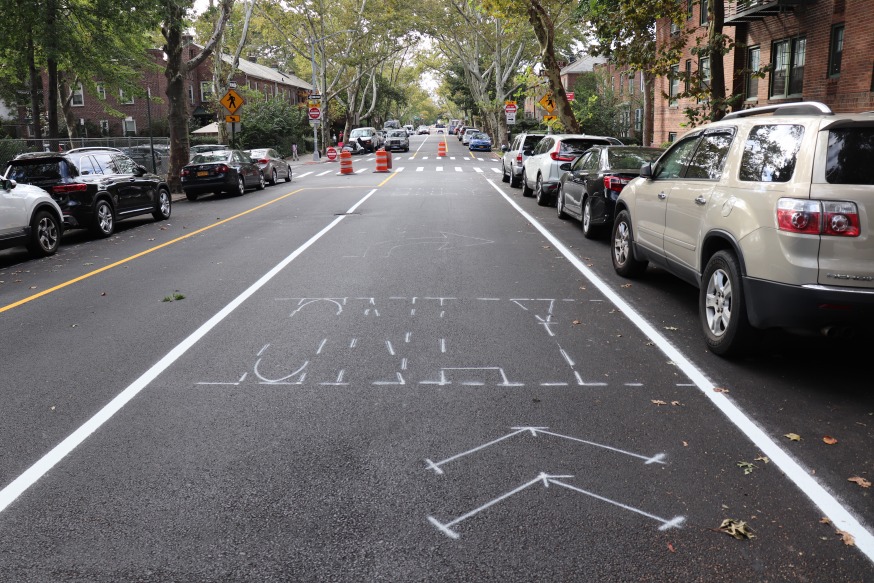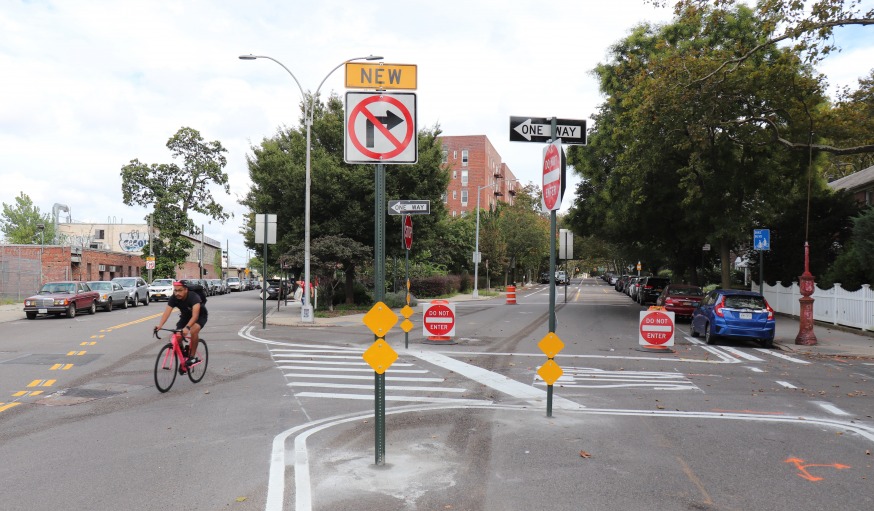
The DOT was criticized Thursday for the way it rolled out its 39th Avenue Bike Boulevard plan, which is still in the process of being completed (Photo by Michael Dorgan, Queens Post))
Oct. 8, 2021 By Christian Murray
The Queens Commissioner of the Department of Transportation told residents during a Community Board 2 meeting Thursday that the controversial 39th Avenue Bike Boulevard remains “a work in progress” and asked for “patience.”
“This is a creative, innovative treatment–the first of its kind in the borough,” said Queens DOT Commissioner Nicole Garcia at the meeting, which was held via Zoom. “What we are asking for is a little bit of patience. We know there is a little bit of confusion.”
Garcia said the plan has yet to be fully implemented and that many changes such as new signage and pedestrian ramps have yet to be installed. She said the DOT is working as quickly as possible to get the project done and that people should wait for it to be completed before coming to a final conclusion.
Garcia said she joined the meeting to get feedback from board members and the public.
“Once construction is complete, we are happy to do walk-throughs and figure out what we can tweak– to make a good project even better,” Garcia said. “The DOT has already been hearing about the benefits of the plan, such as how it is reducing the amount of through traffic and making it safer for the residents on the block.”

The 45th Street intersection at Barnett Avenue during the early stages of construction (Photo by Michael Dorgan, Queens Post)
Construction began at the end of September and the plan has seen various portions of 39th Avenue and Barnett Avenue—that were previously two-way roadways—converted into one-way zones. The change has created space for a protected bicycle lane and pedestrian safety features.
The plan, however, got a mixed reception from the board Thursday, with some praising the DOT for creating a bike boulevard in the district—while others said the plan has led to confusion.
Lisa Deller, chair of Community Board 2 and a Sunnyside Gardens resident, said the DOT did a poor job in rolling out the plan.
“The implementation has really been so disruptive to the neighborhood…DOT has to do better on projects like this,” she said.
She said the DOT should have had staff on the ground talking to residents to explain the changes when construction began. She said many residents were caught by surprise and “the confusion and disruption for people in the neighborhood has been so extreme.”
Thomas Mituzas, a board member and co-chair of the Transportation Committee, also questioned the DOT on its rollout.
“I would think that if the DOT thought that this was an important project we would have seen more people on the ground talking to the neighborhood and being involved and I did not see that,” Mituzas said.
But the actual plan was praised by many board members.
Amparo Abel-Bey, a board member and a 39th Avenue resident, complimented the DOT for the plan.
“I want to thank you for this project,” Abel-Bey said.
Laura Shepard, a board member who is also a volunteer with Transportation Alternatives Queens, said: “We are thrilled to have Queens’ first bike boulevard. I know this is a change and an adjustment…but already you are seeing some of the benefits. We don’t have drivers using it as a cut through, speeding is down. We are loving the new crosswalks and seeing all sorts of people bicycling…so thank you for this.”
But many residents who spoke during the public comment period were less complimentary, with some calling for the plan to be reversed. More than 40 signed up to speak but many were unable to participate.
Community Board 2 had capped the maximum number of participants on Zoom to 100. With 50 board members and various officials, the number of spots left for the public to get on the call was limited.
One resident complained in the Zoom chat room.
“This meeting was capped at 100 and it took me one hour to be admitted,” wrote resident Amanda Lefer.
Deller said the cap was an oversight and that the board didn’t anticipate so many people would want to partake in the meeting. She said the cap would be increased at future meetings.
The opponents of the plan—and there were many—were blunt in their assessment of it.
“I think the design is terrible. The result has been chaos. It has not calmed traffic,” said Gerald Perrin, a lifelong Phipps Garden Apartments resident.
He said that he now has to drive several additional blocks in order to get to his apartment. He also said that 39th Road near Phipps Garden Apartments has gone from a quiet narrow street to a busy through street. “39th Road is bedlam,” he said.
Debbie Farley, a Sunnyside resident, said the plan “is confusing at best. There is a lot of congestion.”
She wondered what was in store for residents when Phipps starts constructing its 167-unit apartment complex on Barnett Avenue and the city builds the 720-seat middle school at 38-04 48th St. “What will the effect be when trucks start coming in.”
“You are creating chaos and then say it is a work in progress,” Farley said.
Other speakers discussed how parking spaces had been lost and how some streets off 39th Avenue had become congested. Some also argued that the bike boulevard had become more dangerous particularly for pedestrians—stating that e-bikes, mopeds and regular bicycles are speeding or going in the wrong direction.
But several Sunnyside residents spoke in favor of the proposal during the public comment period.
“I’ve been shocked to see the improvement in the quality of my life already…I am looking forward to the full implementation,” said Philip Leff, who lives on 39th Avenue.
Max Diamond, another resident, also praised the plan and said even in its partially constructed state it was an improvement.
Some speakers praised the plan for providing a safe bicycle connection to Jackson Heights. They said that the new bike boulevard had already made it safer for bicyclists—and less cars on the roadway is good for the environment.
But some speakers wanted to know why the DOT selected 39th Avenue for its first Queens bike boulevard in the first place—and what role the community played in that decision. They argued that the DOT was not being very transparent.
“The lack of data shared [by the DOT] has been concerning, “ said Chris Mitchell, a local resident.
“Looking back at the presentation at the community board [on June 23] there was no data provided regarding the selection of this area. I ask that the DOT make that information available to the community.”
He said the community needs to know what metrics are being collected and how the project is being evaluated in order to objectively look at its effectiveness.
“As you see from people testifying tonight, people’s bias shows through. Some people think everything has been fixed overnight and others think everything has gone to hell.”
